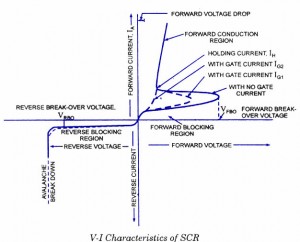
As already mentioned, the SCR is a four-layer device with three terminals, namely, the anode, the cathode and the gate. When the anode is made positive with respect to the cathode, junctions J1 and J3 are forward biased and junction J2 is reverse-biased and only the leakage current will flow through the device. The SCR is then said to be in the forward blocking state or in the forward mode or off state. But when the cathode is made positive with respect to the anode, junctions J1 and J3 are reverse-biased, a small reverse leakage current will flow through the SCR and the SGR is said to be in the reverse blocking state or in reverse mode.
When the anode is positive with respect to cathode i.e. when the SCR is in forward mode, the SCR does not conduct unless the forward voltage exceeds certain value, called the forward breakover voltage, VFB0. In non-conducting state, the current through the SCR is the leakage current which is very small and is negligible. If a positive gate current is supplied, the SCR can become conducting at a voltage much lesser than forward break-over voltage. The larger the gate current, lower the break-over voltage. With sufficiently large gate current, the SCR behaves identical to PN rectifier. Once the SCR is switched on, the forward voltage drop across it is suddenly reduced to very small value, say about 1 volt. In the conducting or on-state, the current through the SCR is limited by the external impedance.
When the anode is negative with respect to cathode, that is when the SCR is in reverse mode or in blocking state no current flows through the SCR except very small leakage current of the order of few micro-amperes. But if the reverse voltage is increased beyond a certain value, called the reverse break-over voltage, VRB0 avalanche break down takes place. Forward break-over voltage VFB0 is usually higher than reverse breakover voltage,VRBO.
From the foregoing discussion, it can be seen that the SCR has two stable and reversible operating states. The change over from off-state to on-state, called turn-on, can be achieved by increasing the forward voltage beyond VFB0. A more convenient and useful method of turn-on the device employs the gate drive. If the forward voltage is less than the forward break-over voltage, VFB0, it can be turned-on by applying a positive voltage between the gate and the cathode. This method is called the gate control. Another very important feature of the gate is that once the SCR is triggered to on-state the gate loses its control.
The switching action of gate takes place only when
(i) SCR is forward biased i.e. anode is positive with respect to cathode, and
(ii) Suitable positive voltage is applied between the gate and the cathode.
Once the SCR has been switched on, it has no control on the amount of current flowing through it. The current through the SCR is entirely controlled by the external impedance connected in the circuit and the applied voltage. There is, however, a very small, about 1 V, potential drop across the SCR. The forward current through the SCR can be reduced by reducing the applied voltage or by increasing the circuit impedance. There is, however, a minimum forward current that must be maintained to keep the SCR in conducting state. This is called the holding current rating of SCR. If the current through the SCR is reduced below the level of holding current, the device returns to off-state or blocking state.
The SCR can be switched off by reducing the forward current below the level of holding current which may be done either by reducing the applied voltage or by increasing the circuit impedance.
Note : The gate can only trigger or switch-on the SCR, it cannot switch off.
Alternatively the SCR can be switched off by applying negative voltage to the anode (reverse mode), the SCR naturally will be switched off.
Here one point is worth mentioning, the SCR takes certain time to switch off. The time, called the turn-off time, must be allowed before forward voltage may be applied again otherwise the device will switch-on with forward voltage without any gate pulse. The turn-off time is about 15 micro-seconds, which is immaterial when dealing with power frequency, but this becomes important in the inverter circuits, which are to operate at high frequency.

15 Comments
Sir,
We are used 500R ratting SCR, during our internal testing the SCR will be failed after analysied The SCr cathode to Gate resistance very low 0.25 Ohms it means cathode to gate short, request your valuabele feedback please. do the needful.
K.Uvaraj
Ph – 9600910240.
Excellent…….!!!
I am very glad to know these concept and i acheved some great experience. Thanks
because of its unequal voltage distribution it has different characteristics…..
Hi Rutuja SCR is like a diode forward it will conduct with a gate trigger and with reverse voltage it will break down at a particular voltage it is called PIV (peak inverse voltage. that is what is indicated in the characteristic graph
why the both sides of characteristics ofscr are different/
Becase it is unidirectional device. When connected in reverse bias J1 and J3 will be in reverse dias thats why small leakage cullent will flow only and if Vak is increase further device will permently brake down and heavy load culrrent will flow. after reduction of load current J1 & J2 will not gain its orignal healthy condition thats why these charactriatics are not same.